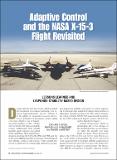| dc.contributor.author | Dydek, Zachary T. | |
| dc.contributor.author | Annaswamy, Anuradha M. | |
| dc.contributor.author | Lavretsky, Eugene | |
| dc.date.accessioned | 2012-05-31T19:34:18Z | |
| dc.date.available | 2012-05-31T19:34:18Z | |
| dc.date.issued | 2010-06 | |
| dc.identifier.issn | 1066-033X | |
| dc.identifier.other | INSPEC Accession Number: 11340970 | |
| dc.identifier.uri | http://hdl.handle.net/1721.1/70967 | |
| dc.description.abstract | In this paper, a new generation of hypersonic vehicles offers a far more effective way of launching small satellites or other vehicles into low-Earth orbit than expendable rockets. Additionally these aircraft facilitate quick response and global strike capabilities. Control of hypersonic vehicles is challenging due to the changes in the aircraft dynamics as the manuever takes the aircraft over large flight envelopes.The field of adaptive control began with the motivation that a controller that can adjust its parameters online could generate improved performance over a fixed-parameter counterpart. Subsequently, sobering lessons of tradeoffs between stability and performance directed the evolution of the field toward the design, analysis, and synthesis of stable adaptive systems. Various adaptive control methods have been developed for controlling linear and nonlinear dynamic systems with parametric and dynamic uncertainties.With the benefit of hindsight and subsequent research, the paper revisit the events of 1967 by examining "how and what if" scenarios.we analyze the X-15-3 aircraft dynamics and the Honeywell MH-96 adaptive controller in an effort to better understand how the sequence of events and the interplay between the controller and the aircraft dynamics might have led to the instability and resulting crash. It follows with a depiction of a Lyapunov-stability-based adaptive controller that incorporates gain scheduling and accommodates actuator magnitude saturation, which we denote as the gain-scheduled, magnitude-saturation-accommodating. | en_US |
| dc.language.iso | en_US | |
| dc.publisher | Institute of Electrical and Electronics Engineers | en_US |
| dc.relation.isversionof | http://dx.doi.org/10.1109/mcs.2010.936292 | en_US |
| dc.rights | Article is made available in accordance with the publisher's policy and may be subject to US copyright law. Please refer to the publisher's site for terms of use. | en_US |
| dc.source | IEEE | en_US |
| dc.title | Adaptive Control and the NASA X-15-3 Flight Revisited | en_US |
| dc.type | Article | en_US |
| dc.identifier.citation | Dydek, Zachary, Anuradha Annaswamy, and Eugene Lavretsky. “Adaptive Control and the NASA X-15-3 Flight Revisited.” IEEE Control Systems Magazine 30.3 (2010): 32–48. Web.© 2010 IEEE. | en_US |
| dc.contributor.department | Massachusetts Institute of Technology. Department of Mechanical Engineering | en_US |
| dc.contributor.approver | Annaswamy, Anuradha M. | |
| dc.contributor.mitauthor | Dydek, Zachary T. | |
| dc.contributor.mitauthor | Annaswamy, Anuradha M. | |
| dc.relation.journal | IEEE Control Systems | en_US |
| dc.eprint.version | Final published version | en_US |
| dc.type.uri | http://purl.org/eprint/type/JournalArticle | en_US |
| eprint.status | http://purl.org/eprint/status/PeerReviewed | en_US |
| dspace.orderedauthors | Dydek, Zachary; Annaswamy, Anuradha; Lavretsky, Eugene | en |
| dc.identifier.orcid | https://orcid.org/0000-0002-4354-0459 | |
| mit.license | PUBLISHER_POLICY | en_US |
| mit.metadata.status | Complete | |
